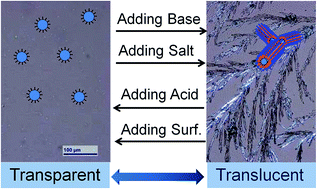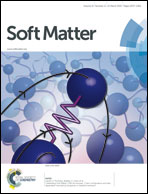Multi-tunable self-assembled morphologies of stimuli-responsive diblock polyampholyte films on solid substrates
Abstract
Intelligent polymers, due to their sensitive stimuli response to changes in the environment, have gained increasing amounts of attention over recent years and have become a popular topic in polymer materials science. In this study, the aggregation behaviors and stimuli responses of the stimuli-responsive diblock polyampholyte poly(2-(dimethylamino)ethyl methacrylate)-b-poly(acrylic acid) (PDMAEMA-b-PAA) are conveniently tunable by introducing pH changes, temperature changes, salt addition and surfactant neutralization. Under different pH values, either globular or fractal self-assemblies can be observed in which the latter have crystal properties. Salts and alkalis can promote the fractal aggregation growth because their deposited crystals can act as nucleation sites for the polyampholyte chains. A combination of fluorescence spectroscopy, atom force microscopy and transmission electron microscopy revealed that the presence of anionic surfactants in the PDMAEMA-b-PAA solutions promoted the solubility of the polyampholyte, consequently leading to a more homogeneous distribution of the polymer chains on the solid substrate upon drying the mixtures. The fractal formation was suppressed for the studied Gemini surfactants, and a higher surfactant hydrophobicity results in an earlier start of the formation of the fractal pattern.


 Please wait while we load your content...
Please wait while we load your content...